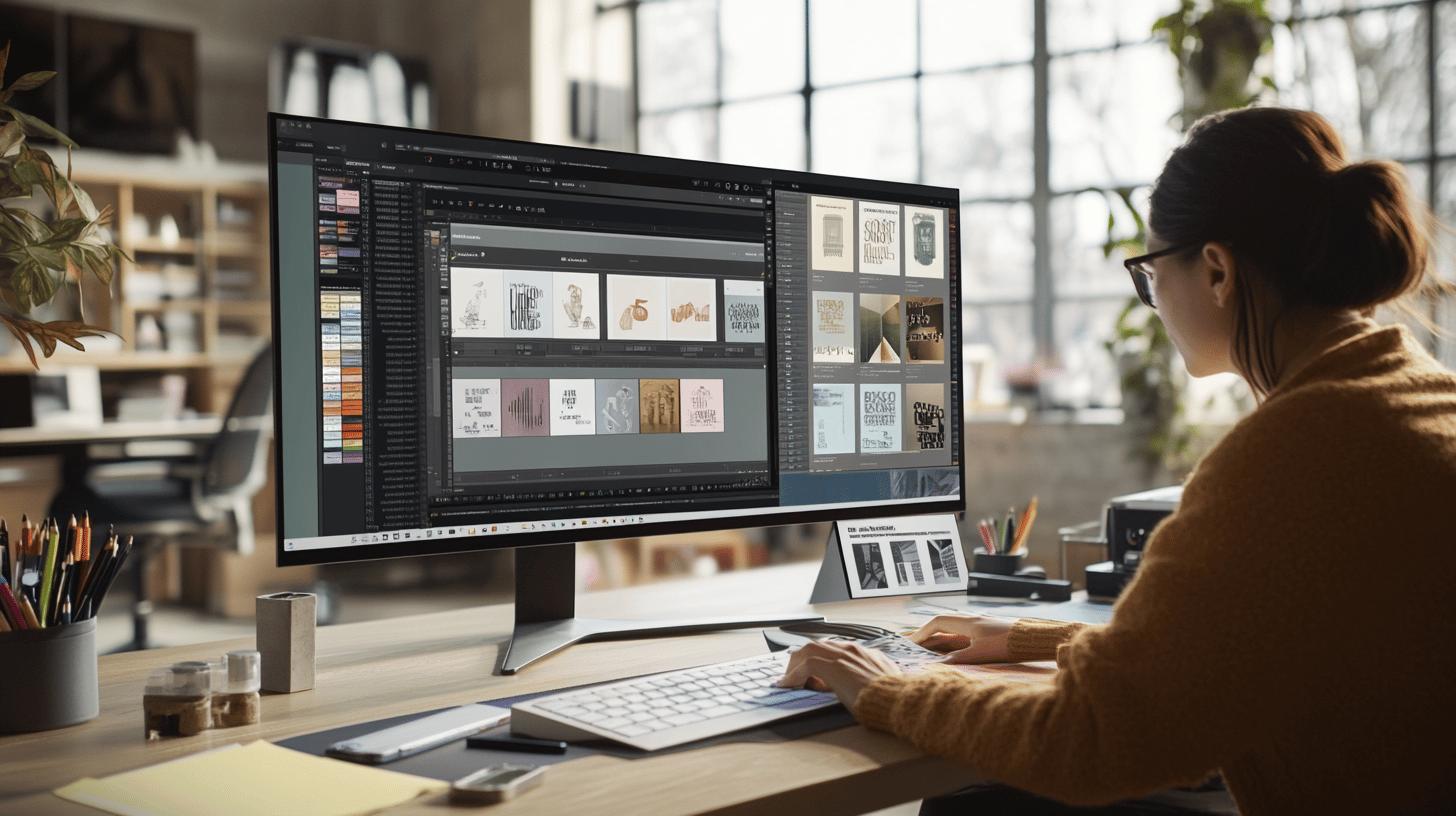JOURNAL
Core Elements of Website Design for Success
Is your website design setting you up for success or failure? With users forming an opinion within just 50 milliseconds, the stakes couldn’t be higher. The layout, colour schemes, typography, and navigation are not just decorative—they are essential elements that can make or break your online presence. In this article, we’ll explore the core elements of website design that drive success, guiding you through best practices to create a visually appealing, user-friendly, and effective website. Ready to elevate your web game? Let’s dive in.
Website Layout Principles and Visual Hierarchy
Users form an opinion of a website within 50 milliseconds, making the overall layout and visual appearance critical. An effective layout helps organise content in a visually appealing and easy-to-navigate manner, enhancing user engagement. The initial impression is often influenced by the structure and visual appeal, determining whether users will stay or leave. Visual hierarchy plays a pivotal role in guiding users through the content, emphasising key elements using size, colour, and spacing. It directs attention to the most important parts of the website, improving usability and ensuring that users find the information they need quickly and effortlessly. Best practices for creating an effective website layout:- Consistent Grid System: Use a grid system to maintain consistency and alignment across the website.
- Whitespace Utilisation: Incorporate whitespace to prevent clutter and improve readability.
- Visual Flow: Arrange elements in a way that naturally guides the user’s eye from one section to the next.
- Prioritise Content: Highlight critical content using larger fonts, bolder colours, or prominent placement.
- Responsive Design: Ensure the layout adapts seamlessly to different screen sizes and devices.
Colour Schemes for Websites
Colour schemes play a crucial role in establishing brand identity and enhancing website aesthetics. They can evoke specific emotional responses from visitors, influencing their perception of the brand and their overall experience. With around 7 million hues available, selecting the right colours can significantly impact user engagement and retention. A well-chosen colour scheme reflects the brand’s personality and makes the website visually appealing, contributing to a cohesive and memorable user experience. When choosing a colour scheme, consider the brand, industry, and target audience. Start by identifying the primary colour that represents the brand, then select complementary colours that enhance it. Ensure the colours align with the brand’s message and evoke the desired emotional response from visitors. For instance, blue often conveys trust and professionalism, while red can evoke excitement and urgency. Additionally, test the colour scheme across different devices to maintain consistency and readability.| Colour | Emotional Response |
|---|---|
| Blue | Trust, Professionalism |
| Red | Excitement, Urgency |
| Green | Growth, Tranquillity |
| Yellow | Optimism, Happiness |
Typography in Web Design
 Typography plays a vital role in creating a cohesive brand identity. It reflects the business’s personality and sets the tone for the website, whether portraying a professional image with serif fonts or a casual vibe with sans serif fonts. Consistent and unique typography across all web pages helps establish brand recognition, making the website memorable to visitors.
Selecting appropriate fonts involves considering the brand’s identity and the target audience. For a professional look, serif fonts like Times New Roman or Georgia are suitable, while sans serif fonts like Arial or Helvetica are better for a modern, clean appearance. It’s crucial to limit the usage to two or three font families to maintain visual harmony. Additionally, ensure the chosen fonts are legible across different devices and screen sizes. Testing the typography in various contexts, such as headings, body text, and call-to-action buttons, helps achieve a balanced and aesthetically pleasing design.
Responsive typography is essential for usability across devices. It ensures that text remains readable and visually appealing, whether viewed on a desktop, tablet, or smartphone. Techniques like relative sizing, media queries, and flexible line heights adjust the typography dynamically based on the user’s screen size. Implementing responsive typography not only enhances user experience but also contributes to the overall accessibility of the website, making it adaptable to an increasingly mobile audience.
Typography plays a vital role in creating a cohesive brand identity. It reflects the business’s personality and sets the tone for the website, whether portraying a professional image with serif fonts or a casual vibe with sans serif fonts. Consistent and unique typography across all web pages helps establish brand recognition, making the website memorable to visitors.
Selecting appropriate fonts involves considering the brand’s identity and the target audience. For a professional look, serif fonts like Times New Roman or Georgia are suitable, while sans serif fonts like Arial or Helvetica are better for a modern, clean appearance. It’s crucial to limit the usage to two or three font families to maintain visual harmony. Additionally, ensure the chosen fonts are legible across different devices and screen sizes. Testing the typography in various contexts, such as headings, body text, and call-to-action buttons, helps achieve a balanced and aesthetically pleasing design.
Responsive typography is essential for usability across devices. It ensures that text remains readable and visually appealing, whether viewed on a desktop, tablet, or smartphone. Techniques like relative sizing, media queries, and flexible line heights adjust the typography dynamically based on the user’s screen size. Implementing responsive typography not only enhances user experience but also contributes to the overall accessibility of the website, making it adaptable to an increasingly mobile audience.
User Navigation and Intuitive Menus
Clear and intuitive user navigation is critical for enhancing user experience. When visitors land on a website, they should be able to find the information they need quickly and effortlessly. Effective navigation not only improves user satisfaction but also encourages longer site visits and higher engagement rates. Poor navigation can frustrate users, leading to higher bounce rates and lost opportunities. Different types of navigation menus cater to various website structures and user preferences. Hamburger menus, for example, save valuable screen space and are particularly effective on mobile devices. They hide the navigation options behind an icon, allowing users to access the menu as needed. Dropdown menus, on the other hand, provide a hierarchical structure, making it easier for users to explore subcategories without cluttering the main navigation bar. Both types of menus should be designed to be easily accessible and operable across different devices and screen sizes. Best practices for intuitive navigation:- Consistent Placement: Keep navigation elements in familiar locations, such as the top or side of the page.
- Descriptive Labels: Use clear and concise labels for menu items to indicate their destination accurately.
- Logical Structure: Organise menu items in a logical order, grouping related items together.
- Mobile Friendliness: Ensure that navigation is easily accessible and functional on mobile devices, using responsive design techniques.
Responsive Design and Mobile-Friendly Websites
Responsive web design is indispensable in modern web development, ensuring that a website looks and functions well across various devices, including smartphones and tablets. With mobile traffic accounting for more than 54% of all web traffic, it is crucial to create websites that offer a seamless user experience regardless of the device being used. Responsive design adapts the layout and content to fit different screen sizes, enhancing accessibility and usability. Best practices for mobile-friendly design include prioritising a compact and user-friendly mobile version of the site. Start by adopting a mobile-first approach, where the design process begins with the smallest screen size and scales up. This approach ensures that the essential elements are optimised for mobile users. Next, employ flexible grids and layouts that adjust dynamically to various screen sizes. Using scalable images and media queries for different breakpoints allows the content to remain visually appealing and functional across devices. Additionally, simplifying navigation and minimising the use of large images or videos can improve load times and overall performance. Essential elements for responsive websites:- Flexible Grid Layouts: Use fluid grid layouts that adjust to different screen sizes and orientations.
- Scalable Images: Ensure images scale correctly without losing quality or causing layout issues.
- Media Queries: Implement media queries to apply different styles based on screen size and device characteristics.
- Simplified Navigation: Design intuitive and accessible navigation that works well on smaller screens.
- Fast Load Times: Optimise content to ensure quick loading, reducing the risk of user abandonment.
User Experience (UX) Design Principles
 User experience (UX) design focuses on creating a seamless and enjoyable interaction for visitors, significantly improving their engagement and satisfaction. A well-executed UX design ensures that users can easily navigate the website, find the information they need, and complete desired actions without frustration. By prioritising the needs and preferences of users, UX design helps build trust and encourages repeat visits, ultimately contributing to the website’s success.
Key elements of UX design include clear calls to action (CTAs) and a strategic content plan. CTAs are essential for guiding users towards specific actions, such as making a purchase, signing up for a newsletter, or contacting the business. Effective CTAs are prominently placed, visually distinct, and use compelling language that encourages clicks. A strategic content plan involves organising and presenting information in a way that is logical, relevant, and engaging for the target audience. This includes using headings, subheadings, bullet points, and multimedia elements to break up text and improve readability. Ensuring that the website’s content aligns with user expectations and goals enhances the overall user experience.
UX metrics to track:
User experience (UX) design focuses on creating a seamless and enjoyable interaction for visitors, significantly improving their engagement and satisfaction. A well-executed UX design ensures that users can easily navigate the website, find the information they need, and complete desired actions without frustration. By prioritising the needs and preferences of users, UX design helps build trust and encourages repeat visits, ultimately contributing to the website’s success.
Key elements of UX design include clear calls to action (CTAs) and a strategic content plan. CTAs are essential for guiding users towards specific actions, such as making a purchase, signing up for a newsletter, or contacting the business. Effective CTAs are prominently placed, visually distinct, and use compelling language that encourages clicks. A strategic content plan involves organising and presenting information in a way that is logical, relevant, and engaging for the target audience. This includes using headings, subheadings, bullet points, and multimedia elements to break up text and improve readability. Ensuring that the website’s content aligns with user expectations and goals enhances the overall user experience.
UX metrics to track:
- Bounce Rate: Measures the percentage of visitors who leave the site after viewing only one page, indicating the content’s relevance and engagement level.
- Session Duration: Tracks the average time users spend on the site, reflecting their interest and engagement with the content.
- Pages Per Session: Indicates the number of pages a user views in a single session, providing insights into site navigation and content effectiveness.
- Conversion Rate: Measures the percentage of visitors who complete a desired action, such as making a purchase or filling out a form, revealing the effectiveness of CTAs and overall UX. Best practices for improving UX include conducting regular usability testing to identify and address pain points, ensuring fast page load times to reduce user frustration, and maintaining a consistent design language across the website to enhance familiarity and ease of use. Additionally, incorporating feedback mechanisms, such as surveys or user testing, allows for continuous improvement based on real user experiences. By focusing on these best practices, designers can create a website that not only meets user needs but also drives engagement and conversions.
SEO for Web Design
Integrating SEO into web design is paramount for achieving high search engine rankings and providing a seamless user experience. SEO, or Search Engine Optimisation, ensures that a website is easily discoverable by search engines, thus driving organic traffic and potential customers. Without SEO, even the most beautifully designed websites can remain invisible to users searching for relevant content, products, or services. Key SEO elements in web design include SEO-friendly URLs and image optimisation. SEO-friendly URLs improve readability and search engine rankings by making URLs descriptive and keyword-rich. For example, “www.example.com/seo-tips” is more effective than “www.example.com/page1”. Image optimisation involves reducing file sizes without compromising quality, ensuring faster loading times. This not only enhances user experience but also positively impacts SEO, as search engines favour websites that load quickly. Additionally, using descriptive file names and alt text for images helps search engines understand the content, further improving visibility. Best practices for SEO-friendly web design:- SEO-Friendly URLs: Create descriptive and keyword-rich URLs that are easy to read and understand.
- Image Optimisation: Reduce image file sizes and use descriptive file names and alt text.
- Fast Load Times: Optimise page load times by minimising HTTP requests and using efficient coding practices.
- Mobile Optimisation: Ensure the website is mobile-friendly, as search engines prioritise mobile-first indexing.
Final Words
Designing a website involves several Core Elements of Website Design, each contributing to the site’s effectiveness and user experience. Effective layout and visual hierarchy are critical for creating positive first impressions and guiding user attention. Colour schemes should align with brand identity, while typography enhances brand consistency and usability. User navigation must be intuitive, and responsive design is essential for mobile performance. Lastly, integrating UX principles and SEO strategies ensures the site is both user-friendly and optimised for search engines. Embracing these elements can significantly enhance your website’s functionality and appeal.FAQ
What are the 7 C’s of designing an effective website?
The 7 C’s of designing an effective website are:- Context: Layout and design.
- Content: Text, images, video, and audio.
- Community: Enabling user interaction.
- Customisation: Tailoring the site to different users.
- Communication: User and site interaction.
- Connection: Links to other sites.
- Commerce: Enabling business transactions.
What are the 5 major components of a web page?
The 5 major components of a web page are:- Header: Contains the title and navigation links.
- Content Area: Main information and media.
- Footer: Business info and links.
- Sidebar: Additional navigation or adverts.
- Navigation Bar: Links for easy site navigation.
What are the basic elements of good website design?
Basic elements of good website design include:- Clear navigation
- Consistent typography
- Effective use of white space
- High-quality images and graphics
- Responsive design
What are the six elements of web development?
The six elements of web development are:- Layout: Overall site structure.
- Content: Information and media.
- Visual Design: Graphics and aesthetics.
- Navigation: Easy access to site sections.
- Performance: Loading speed and efficiency.
- Functionality: Interactive features and forms.
